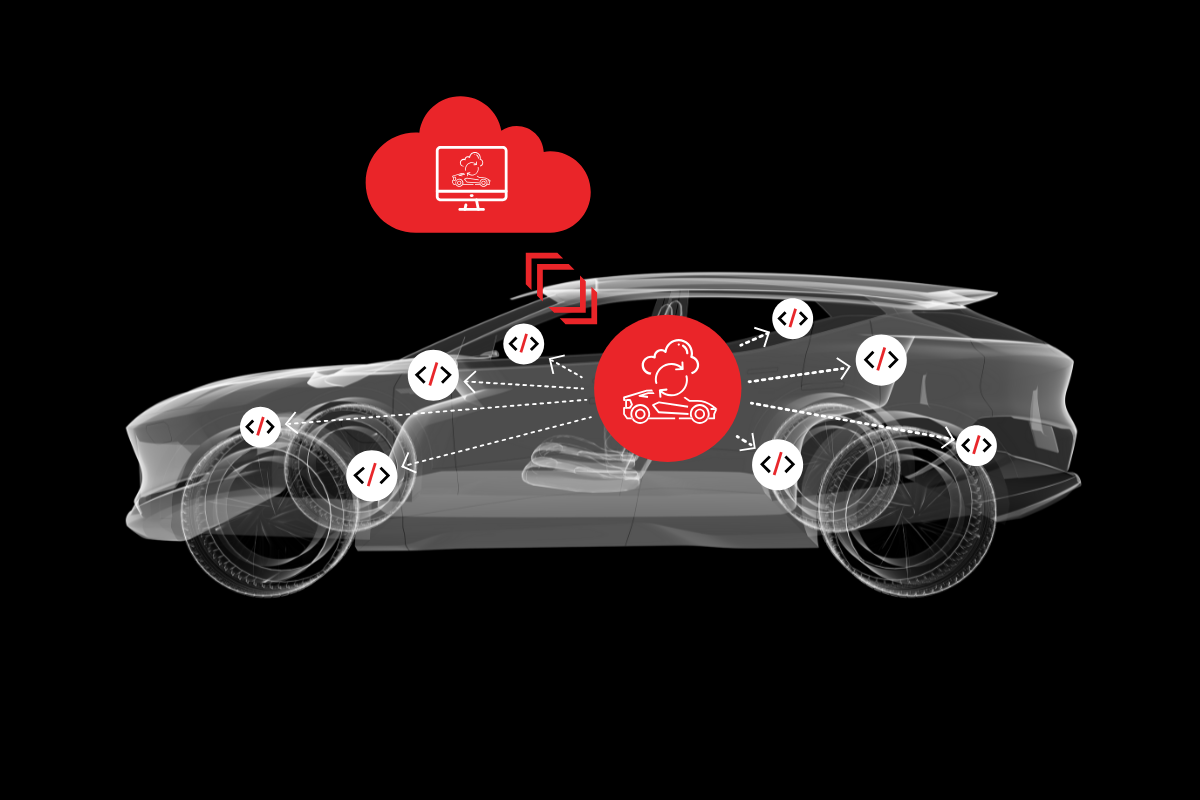The Garage Podcast : S2 EP11
Steve Bell of Wards Intelligence
Steve Bell, Chief Analyst, Connectivity, Wards Intelligence joins host John Heinlein, Ph.D., Chief Marketing Officer, Sonatus to discuss vehicle connectivity, the evolution of cellular networks from 4G to 5G and their application to vehicles, cybersecurity, V2X and the automotive industry’s “Shanghai moment”. Aviation buffs, don’t miss the fun facts of this episode.
Listen to audio only version:
Episode Transcript | Steve Bell of Wards Intelligence
Table of Contents
- Overview
- Meet Steve Bell
- About Wards Auto and Wards Intelligence
- 4G to 5G Transition
- 5G key differences
- Growth of vehicle data
- The importance of trust
- Cybersecurity benefits trust
- SDV’s benefit cybersecurity
- OTA updates benefit cybersecurity
- V2X and connectivity
- Different “clock speeds” across technology
- The Shanghai Moment
- Virtualization
- Conclusion
Overview
JOHN: Today in The Garage, we’re recording live from Auto Tech Detroit with Wards Intelligence. Let’s go.
JOHN: Welcome to The Garage. I’m John Heinlein, Chief Marketing Officer with Sonatus. We’re recording live from Auto Tech Detroit. And today’s special guest is Steve Bell. Steve is Chief Analyst for Connectivity from Wards Intelligence. Steve, welcome to The Garage.
STEVE: Thank you for having me, John.
JOHN: Thank you. And so, you know, the first thing I hope you’ll tell us a little bit about you and your role at Wards.
Meet Steve Bell
STEVE: So I’ve been with Wards for roughly five years. I was formerly with Heavy Reading, sort of covering telecoms. And then my background before that was I had my own startup– which, well I had to get another job because I used all my money in the startup– but it was an interesting lesson. And then I did consultancy, but I was with Motorola for 25 years.
JOHN: Wow.
STEVE: Primarily on connectivity. Everything from two-way radios to, you know, cellular. From analog right all the way through to WiMAX, which was the pre-player to LTE. I’ve also got a background that goes way back – and I’m not giving up my age – but it’s… I was in hydraulics for ten years before I ever got into electronics.
JOHN: Wow.
STEVE: And, so what’s interesting now is the convergence of that knowledge I had working with automotive and then telecoms and all of the new dynamics of the network coming into automotive. And it’s been an interesting journey. You sometimes look back and you say, why do things happen? And you sort of get a sense of karma sometimes that, oh, that’s really interesting, the reason I did that, and now it’s sort of, you know, it’s played to my advantage here.
JOHN: I’ve got a number of examples of my career where some experience I had before has come back to benefit in the future. So it’s fun how that works out that way.
STEVE: Absolutely. And as a role, basically, I mean, it’s connectivity. But, you know, as we’ve been emphasizing in this conference, connectivity is the backbone to so much of the transformation that’s happening within the industry, whether it’s software-defined vehicle, whether it’s the implementation of digital twins, you know, the extension into the supply chain, how you’re tracking parts, knowing where parts are extending, right, in terms of the ability to look after the vehicles for 15, 20 years. So that connectivity aspect is fundamental. So it’s a simple word, but it is also about all of the adjacent technologies that come to it. So…
JOHN: I mean– and we’re kind of getting ahead of ourselves– but I think you’re right. Connectivity as an enabler, can unlock so many more. But let’s get to that! We always begin our episodes by learning about our guests and getting some connection to the guests. You got to tell us some fun fact about you. You kind of did it with the hydraulics. You almost kind of ticked the box there. But you got to tell us something more personal about you. Give me a hobby of yours or something fun that people don’t know about you.
STEVE: So, I was always interested in aviation. Wanted to be a pilot, but the dodgy eyes were sort of like going to take that out of the picture. So I’ve always traveled internationally, but my business life, you know, I got like 3.5 million miles on American and several hundred thousand on most of the other airlines. But pre-9/11, I was– and before I moved to the US– I was going backwards and forwards every other week and I got in pretty good status with BA and they always used to upgrade me. But at that time it was the pilots– the captains used to come down and greet people.
JOHN: Right.
STEVE: And I was lucky enough to multiple times sit in the jump seat. So I’ve landed quite often in Heathrow, but I’ve done Miami, Dallas, Chicago, Los Angeles. And also–
JOHN: From the cockpit? This was pre-9/11, I don’t think you can do that anymore.
STEVE: No. They don’t do it anymore. But it was just so cool.
JOHN: That is such a cool story. I can’t top that story. I actually do really enjoy watching YouTube videos of the cockpit. There’s a whole thing about, you know, cockpit videos.
STEVE: Oh yeah, it’s fascinating.
JOHN: And there’s a number of really incredible ones, especially some of the newer
planes. I can’t touch your story about landing. I would kill for that story, but one time, I used to be – when 747’s were in the United Fleet. They’re kind of retired now– I used to sit in the upper deck a lot of times, and that’s right by the cockpit. And I got on board real early one day, and the pilots were just, you know, and I went to sort of chatting the pilots. And I did get to sit in the pilot’s seat of a 747 one time. That was a real treat because it was real– it wasn’t like a model it was the real thing.
STEVE: Yeah, absolutely.
JOHN: Very cool.
STEVE: And the other best part, and which was the sort of the cream on the cake for me, was I got on one of the last Concorde flights out of New York to London as well.
JOHN: Nice.
STEVE: Always wanted to do it, and it was just spectacular.
About Wards Auto and Wards Intelligence
JOHN: I believe it. Fantastic. So moving on to the topics– I would like to give our listeners for a few moments who may not be familiar– You know, Wards is a massive company. Wards Intelligence is a really important part of Wards. Can you tell us just about kind of the scope of what Wards Intelligence does, because it’s very wide.
STEVE: So we’re part of… It was Wards Intelligence and Wards Auto. And as you know, it’s our 100th year.
JOHN: That’s right. Very exciting.
STEVE: So this was a birthday celebration. And Wards Auto started by basically counting the cars that were coming off of the production line. And the car manufacturers didn’t want to give the data. So Al Ward sent out reporters to stand at the gates and ask the workers when they’re coming off of the line, how many cars did you produce today? And then they would gather it all up, and then they…
JOHN: That’s a great story. I didn’t know that.
4G to 5G Transition
STEVE: Yeah. And so we’ve always been, and we’re known for, the data on vehicle production and the statistics around, you know, what’s in the vehicle. What we supplemented that with over the last, you know, 5 to 10 years, is really looking at the adjacent technologies. You know we focused on the history, but we’re also looking at the future technologies and how the industry is changing. So, you know, as I was saying, connectivity and software-defined vehicles is a key focus for us. Smart cockpits, batteries, electronics, and so forth. And we’re then part of the informa group. So we have a big brother called Omdia, which is the, you know, a large, research company. So we can leverage both and we can… So I’ve just done a report, for instance, on automotive cyber security, and we’ve leveraged it with a cyber security specialist from Omdia, but with an automotive focus, looking at the vendors, looking at the landscape.
JOHN: That’s great. Fantastic. Well, we started talking earlier about connectivity. And I know that’s your key focus area. There’s been a lot of conversations – we’ve been in some conversations here at the show – about connectivity. What are some of the things you’re seeing and the important trends right now?
STEVE: I think you said that you had, Matt Harden from AT&T.
JOHN: Yeah, he’s one of our other guests this week, yeah.
STEVE: So, you know, he probably talked about this transition 4G, 5G. 5G started in North America in 2019. But in 2024, there are very few manufacturers that have 5G modems in the vehicle.
JOHN: Right
STEVE: Within the next two years, you’re going to see that change. All of the manufacturers will have it. But then you have to ask the question, why? And the reason is the network. They installed the 4G radios or the 5G radios, but they kept the old 4G core. And they need that new virtualized 5G core to be able to deliver all of the advanced services. So when you looked at it in terms of, are there any advanced services being delivered? No. Is it a major uplift in terms of capacity or in terms of the speed of the data? No. So why do I want to pay an extra 100 plus bucks to put this modem in? Because this industry is still driven by cost?
JOHN: Right.
5G key differences
STEVE: So that’s part of the challenge. But the good thing is that with those new modems, then you start to see new service opportunities being emerged, one of which is, you know, quality on demand.
JOHN: Right.
STEVE: So as you start to think about critical communications, having that quality delivery is… and having even potentially a dedicated slice of the network.
JOHN: Yeah. These virtual network slicing, not a lot of people know about that. But you can effectively have a piece of a network that’s guaranteed quality, guaranteed latency and so on. And that lets you do very new things that you couldn’t do before.
STEVE: Yeah. And T-Mobile properly, you know, they’ve been doing stuff. Like the formula one race in Las Vegas. They had a dedicated slice that was delivering for the race teams and also for all of the vendors there. So it was probably one of the first deployments and actual sort of commercialization of the network capability. So it’s pretty good.
Growth of vehicle data
JOHN: There’s been many conversations– and even in the panel I was on yesterday– talking about vehicle data. I mean, the proliferation of software and vehicles and software-enabled components is causing an increase in the potential data coming out of vehicles. I mean, terabytes of potential data out of vehicles. What’s your take on, how do we go through that giant haystack of data to get value? We have a perspective, but I’d love to hear your perspective.
STEVE: Well, you know there’s this expression, that data is the new oil.
JOHN: Yeah.
STEVE: But I extend that a little bit, and that is that if you’ve got the Permian Basin or if you’ve got Saudi Arabia and it’s sitting on a huge oil field, but you don’t have the mechanism to extract it, and you don’t have the processes to turn that oil into consumables and create value. Then it’s got potential, but it’s not necessarily a commercial value. We’re still at that early stage. We’re looking at how do you extract that data? What do you put around it to commercialize it? How can you use it for the benefit of the consumer? One of the speakers in the main session yesterday, was a lady called Sue Bai from Honda.
JOHN: She was on the panel with me.
STEVE: Yeah, yeah. And so she made it a very human story. You know, she moved to California in her new role. She went to the State Park, and she realized that all of the toilets in the state park for campers were immaculately clean. And she was like, why? And so she visited all the toilets and they were all clean. And then she realized the community of campers, it’s in their best interests to essentially keep them clean. So then she takes this analogous leap, and says, if we can use the data from the vehicles, can we get people that drive respectfully in their neighborhood to also be more harmonious on freeways? You know, because they’re giving back? So they asked the driver… they’re asking their drivers to consent to give details of potholes or, you know, roadworks, or construction…and in that process, they’re building a community and that community of road owners, if you like, that have, you know, a vested interest. So that’s using data in a totally different way. And she said everybody hates the “M” word, “monetization.”
JOHN: Sure.
STEVE: But it’s about how do you create value and how do you create community? And I think that’s the opportunity.
The importance of trust
JOHN: So Sue was on the panel with us yesterday and we talked about a number of topics like this. I fear that some of that is a little altruistic about sharing the freeways, but the idea is good. But what we did talk about is the importance of trust.
STEVE: Yeah.
JOHN: And if, because consumers today, you know, pretty much if you’re not careful, will opt out of everything because they don’t trust automakers. And there’s been some notable scandals as of late where data was perhaps misused or inappropriately shared. But if we’re able to build that trust, the reality is there’s a ton of benefit that benefits, you know, the automakers, yes. But also the consumers as well, vehicles getting better and so on. And so I think we have to be more transparent about that and help. So that part I agree with her very much.
STEVE: Well, and there’s also the aspect, I mean, there was another keynote this morning, from Stellantis saying, well, you know, if we know how a vehicle is being treated, then when that vehicle comes in as a used vehicle and we’re reselling it, then we know what needs to be looked at. But we can also certify that in a way that is totally different for the next owner.
JOHN: It’s true. And, you know, we have this Carfax company in the US, I don’t know if it’s worldwide, where you can get the vehicle history, but it’s relatively coarse. It’s, was it in an accident? Did it have, you know, bodywork or whatever? But what you don’t know is, was it driven like the proverbial old lady on Sunday, or was it driven like a race car all the time? So imagine, for conceptual sake, for purposes that you’re reselling your vehicle and you’re a good driver. You drive carefully, you drive respectfully. Well, actually, the vehicle’s probably in better shape than someone who drives it maybe… stop and start all the time or was an Uber driver or whatever. So it’s in your best interest potentially to share that data. If we can begin to communicate that vision, and I think the data can become really benefiting everyone.
STEVE: And that’s the key. It’s… The trust is built when they can see the benefit is delivered, but it’s also that there’s no violation of that trust.
JOHN: Right.
Cybersecurity benefits trust
STEVE: And that that’s you know, cybersecurity is a key aspect, alright? We did a presentation earlier on this, this week about connectivity and software-defined vehicles and, and the fact that when you’re looking at that software-defined vehicle stack, you’ve got to think about connectivity and cyber security across the whole stack.
JOHN: Right.
STEVE: Right from the initial hardware, right the way through to the application level and the connection to the cloud. You have to bring people into the design process earlier. You can’t… So the connectivity specialist– the cyber security specialist– can’t be a bolt on later on. As you’re designing your platforms, as you’re designing these new software defined platforms, you have to have those specialists engaged early in the design phase, and now you’ve got this opportunity with, you know, the digital twin and the whole sort of the hardware-software design process being done in the cloud that you can accelerate that process. So bringing them in early and allowing them to participate, basically helps you establish that baseline of trust.
JOHN: That’s right.
STEVE: And then securing that going forward.
SDV’s benefit cybersecurity
JOHN: That’s right. So one of the things Sonatus does is we have a product called Sonatus Foundation in production today with, our, you know, our OEM partners. And one of the features of it is cybersecurity. Things like network firewalls, finding out some of the normal things in computing today, making sure we’re bringing those same standards into vehicles to protect them as well. And I think there’s also, you mentioned about cyber security, and I think there’s a fallacy maybe that in cybersecurity, the software-defined vehicles are the ones at more risk because there’s more software. But I think it’s more complicated than that.
STEVE: Yeah, I mean, you know, and I know, that vehicles have got 100 million lines of code, in some of the high-end ones.
JOHN: Yeah. Today. Yeah.
STEVE: And some of them have got less than that. That’s a real complication in terms of how do you update that? If you know that there’s a flaw, all right, that means you’ve got to do a physical recall.
JOHN: Right.
STEVE: Okay. The vehicles that are going out onto the roads now, the software-defined vehicles that have over-the-air update capability and have to be compliant, at least outside of the U.S. and in Europe and wherever, with UM155 and 156.
JOHN: Right.
STEVE: They have to know their software bill of materials . They have to be able to ensure that they can update that vehicle. And what is really important is that under those regulations, they have to support those vehicles until the last vehicle of the vehicle type is out of the market. And that’s not like, oh, you know, we’re not just going to update this any longer. It’s like, the last vehicle of the vehicle type is out of the market. So that could be 20, 25 years. That’s a timeframe that nobody’s been talking about. You’ve got to have that ability to update the vehicle.
OTA updates benefit cybersecurity
JOHN: Yeah, it’s funny because when we talk about OTA updates all the time and in the show, it’s a very hot topic. It’s still relatively early days in proliferating OTA. But I think a lot of people think of OTA as, oh, I have an app store or I’ll be able to, you know, update the nav system. But thinking about OTA is being able to fix, for example, cybersecurity problems and many other things. I think it’s a very powerful new way to think about it and motivate the need for OTA.
STEVE: So, and to your point, the older vehicles are less secure than the OTA-enabled software-defined vehicles that are coming out. And that’s something that people need to be conscious about. Certainly the OEMs, I think, are aware. And as you start to talk about trust, that’s a key issue going forward.
JOHN: So the reality is the software-defined vehicles are the safer ones.
STEVE: Yes.
V2X and connectivity
JOHN: That’s great. Since you’re responsible for connectivity, another important area is V2X You know the vehicle connectivity to other vehicles or to an infrastructure. What’s your outlook on that? It’s still been slow going right now for V2X. What’s your take?
STEVE: So 1998 was when the concept came about. 2001, there was some spectrum allocated by the FCC. And then by about 2010 the specifications were there. 2020, you know, the FCC said you haven’t done anything with this spectrum. The 75MHz here. Wi-Fi has gone nuts. We need to take 45 MHz and give it to Wi-Fi. So now you’ve taken this 75 MHz and reduced it down to 30 MHz. And they said, also, you know, technology’s moved on since the original concept, which was, digital short-range communication. Cellular V2X has emerged. And we think that you should go with cellular V2X. But in some respects that was a great decision. But it created all sorts of issues for the industry as a whole. One of them is that the FCC on the other side was saying, you know, 5G is important. We’ve got to push that. We’ve got to push the new technologies. And they know that 5G, new radio V2X, C-V2X, requires 40 MHz, but they’ve only allocated 30 MHz. So you’re essentially trapping the North American market for V2X into the LTE V2X. So essentially, what they call the day-one use cases, not the advanced use cases. So that’s one challenge. And there’s uncertainty until the FCC gives their rule and order, which is that the industry is waiting and hopefully it’s by the end of this year. But the OEMs are sort of stepping back and saying, well, we’re not sure that, you know, what’s going to happen. So I was at ITS, the Intelligent Transport System of America’s conference. And it was an eye-opening experience for me because I’m from a technology side, as we know, so we know the technology is there. But why is it taking so long? And there’s this huge chicken-and-egg situation because they’ve always wanted to have the infrastructure. So it’s vehicle to vehicle and vehicle to infrastructure. So the roadside units. But roadside units are extremely expensive. But there’s another issue, which is that there’s no universal mandate. You’ve got the federal, you’ve got the state, you’ve got the local, you’ve got the city, and they’ve all got to sort of fund this. So the US Department of Transport has got a V2X deployment plan or strategy. They haven’t got the deployment plan yet, but the strategy. And one of the goals is that when you drive from New York to L.A, you have a continuous experience. It’s not different in, you know, Illinois versus Minnesota. So we’ll see what will happen. But the timeline for this is like going out beyond 2030, 2035. I think the other exciting aspect though is that the new technology enables vehicle to network. And that means that you can use the technology… There’s 100 million vehicles out there that have got modems in that could receive information. So you take the sensor data off of the more advanced vehicles, and you use that and the power of the cloud and the power of the network, and you can start distributing that. So there were some concepts about aftermarket pucks that can go into the vehicles. There’s some companies here that are talking about head-up display. So you could start to be able to address that user part, as opposed to waiting for the trickle effect of new vehicles. So in some respects, it’s frustrating. I think new technologies and, you know, adjacent technologies are giving the opportunity to accelerate that much faster.
JOHN: That’s very interesting. So I, I agree with you on the standards and we’ve said that on the show with other guests, that the lack of standards and the way that standards roll out in the US with, you know, state, local, federal is very frustrating. I mean, it’s there for a reason, but at the same time, from a technology standards perspective, it makes things go slow.
Different “clock speeds” across technology
STEVE: Well, and I think the other thing that’s become very apparent here and I’ve been using the expression “clock speed,” because when I look at the different industries, I mean, the software industry’s running at a very fast clock speed. It’s almost a continuous… It is a continuous update. The semiconductor is running at six-month, 12-month cycles. You look at artificial intelligence and that’s running at a faster cycle. Then you look at, you know, the utilities and the utility grid, and then you look at smart cities and then you look at the, you know, transport systems. And they’re running at a different clock speed. And then the automotive industry is now having to adjust to multiple clock speeds. And the mindset is different. You know that.
JOHN: Yeah.
STEVE: So I think this aspect of recognizing the adjacent technologies are moving in a much faster… And can give you an opportunity to move things faster as well if you are open. And if you have an open platform or if you have a software-defined platform that you can add on top of easily.
JOHN: Yeah. It’s interesting you say that. I mean, so many different aspects of that. I think the pace of innovation in auto is slowly accelerating. Frankly, there’s a lot of pressure from Asia, which is moving very quickly, maybe too quickly, but quickly. And it’s forcing everyone to realize they need to try new things. And you’re seeing that across the world. Some successes, some failures. I love the idea of a retrofit approach to bringing V2X data into older vehicles. That’s genius. I hadn’t seen that.
The Shanghai Moment
STEVE: It’s pretty good. I mean, to your point about the cycle time, I mean, I called it the Shanghai moment. It was back in 2023. You know, the German automakers went to Shanghai Motor Show.
JOHN: Yeah.
STEVE: And there was a realization that their cycle time in terms… Has gone… I mean, the industry is usually 5 to 7-
JOHN: 5 to years, yeah.
STEVE: They’re down to 18 months,
JOHN: Or faster, in some cases. It’s crazy.
STEVE: And so when you got back that fundamental difference, you’ve got to change how you’re doing your business and the mindset you’re bringing to it.
JOHN: From our selfish perspective, we think software has a big role to play in there. Of course, software alone can’t do it. But I think those companies that are doing well, and I won’t name names, but those companies that are doing well, are embracing software, and they’re beginning to try to integrate software into their methodology. Earlier, kind of as you said earlier, earlier and in a more fundamental way.
STEVE: So build on that clock speed for a second. You and I have also talked about virtualization.
JOHN: Right.
Virtualization
STEVE: Right. So if you look at the data centers, you know, moving from compute to cloud is essentially all about virtualization in the data center.
JOHN: Right.
STEVE: And then if you look at 4G, 5G, that’s all about virtualization into the network for telecoms. What you’re starting to see is that in automotive with software-defined vehicles, you’re getting that virtualization concept. What is fascinating is when you look at the V2X and the Departments of Transport, they’ve got monolithic software and monolithic systems. And so again, this aspect of if they want to digitalize, they can’t have a plan that’s going to take them out to 2050. This thing’s moving too fast. So virtualization, certainly was… There was no topic that covered virtualization at the ITS Show. And I found that fascinating.
JOHN: Really?
STEVE: Yeah.
JOHN: That’s so interesting. And, you know, virtualization is so fundamental to software-defined vehicles. You know, we talked earlier, cars are driving down the road with 120, 150 computers inside, which is kind of bonkers. The way you solve that is through virtualization where you have more powerful, you know, computers, if you will, more powerful ECUs that do multiple jobs. That’s integral. It’s one of the aspects of a software-defined vehicle. But it’s interesting that it pervades into other parts of it as well. That’s a good perspective.
STEVE: And then you look at that software stack. You know, part of that software stack can be on the vehicle, another part could be in the cloud. But that requires the virtualization mindset.
Conclusion
JOHN: That’s right. There’s cloud native design. So fundamental to that. Well it sounds like we could have another hour conversation, but I don’t think our listeners would stand for it. I’m so grateful for you spending time with us. Look, this show here, Auto Tech, is really your show. It’s kind of your party, as it were. So, I really appreciate you spending time with us. We always enjoy coming here. Last year we had your good friend, Maitê Bezerra on the show, and I was so excited to have you on this year.
STEVE: Thank you for the offer.
JOHN: Thanks for joining us.
STEVE: All right. Cheers, John.
JOHN: I hope you’re enjoying what you’re seeing from The Garage here at Auto Tech Detroit. If you like what you’re seeing, please like and subscribe to see more like it. We hope to see you again in another episode very soon.
Recent episodes
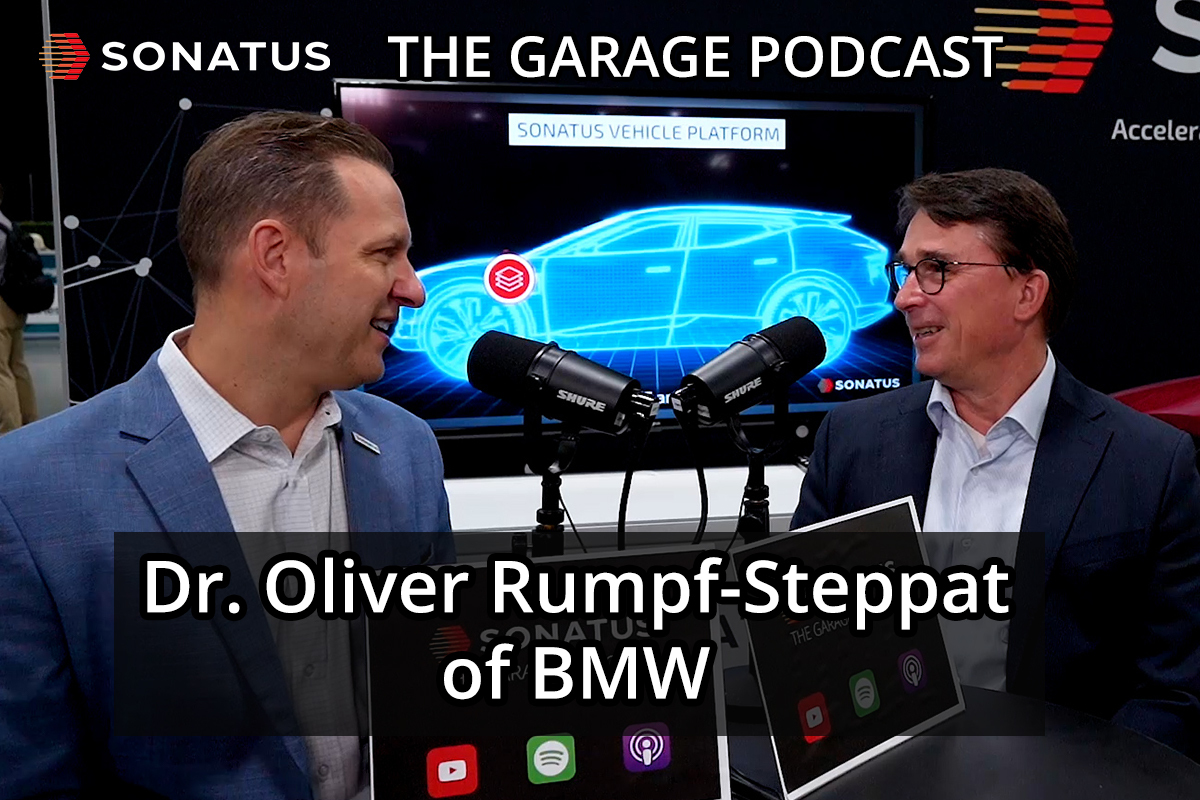
The Garage Podcast
Dr. Oliver Rumpf-Steppat of BMW
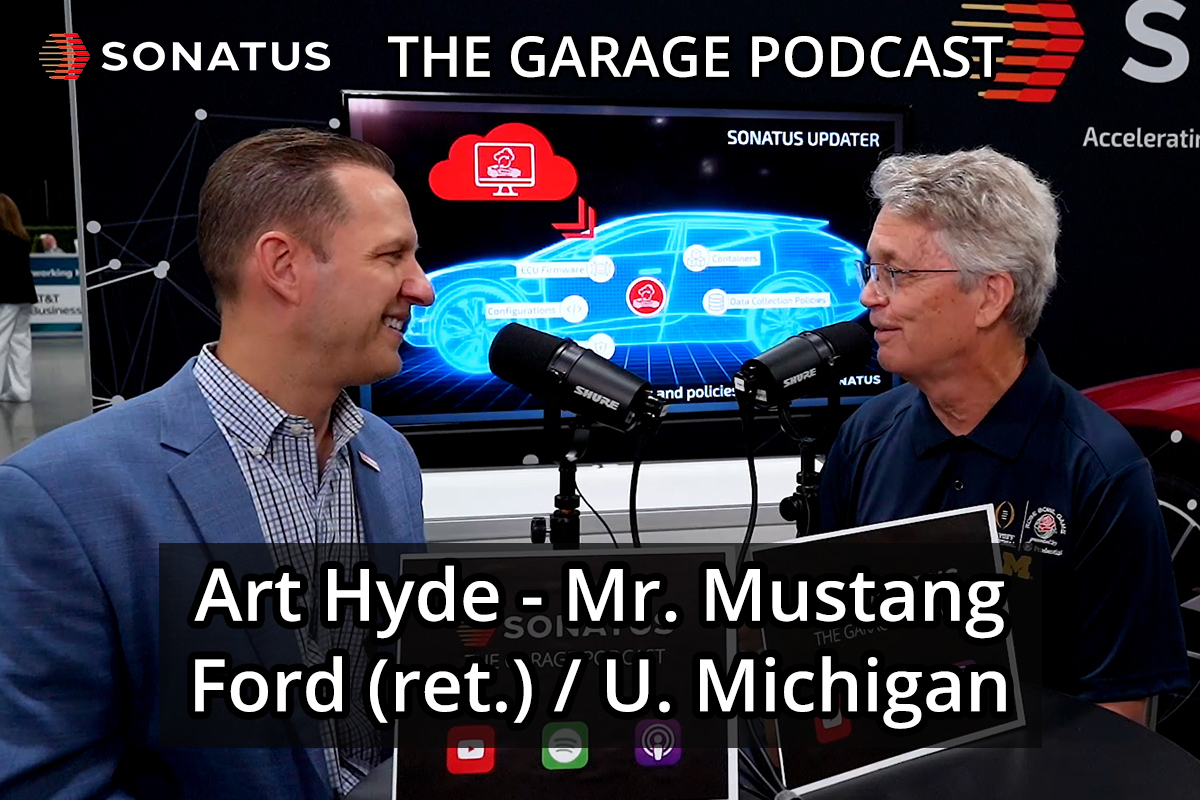
The Garage Podcast
Art Hyde, Mr. Mustang
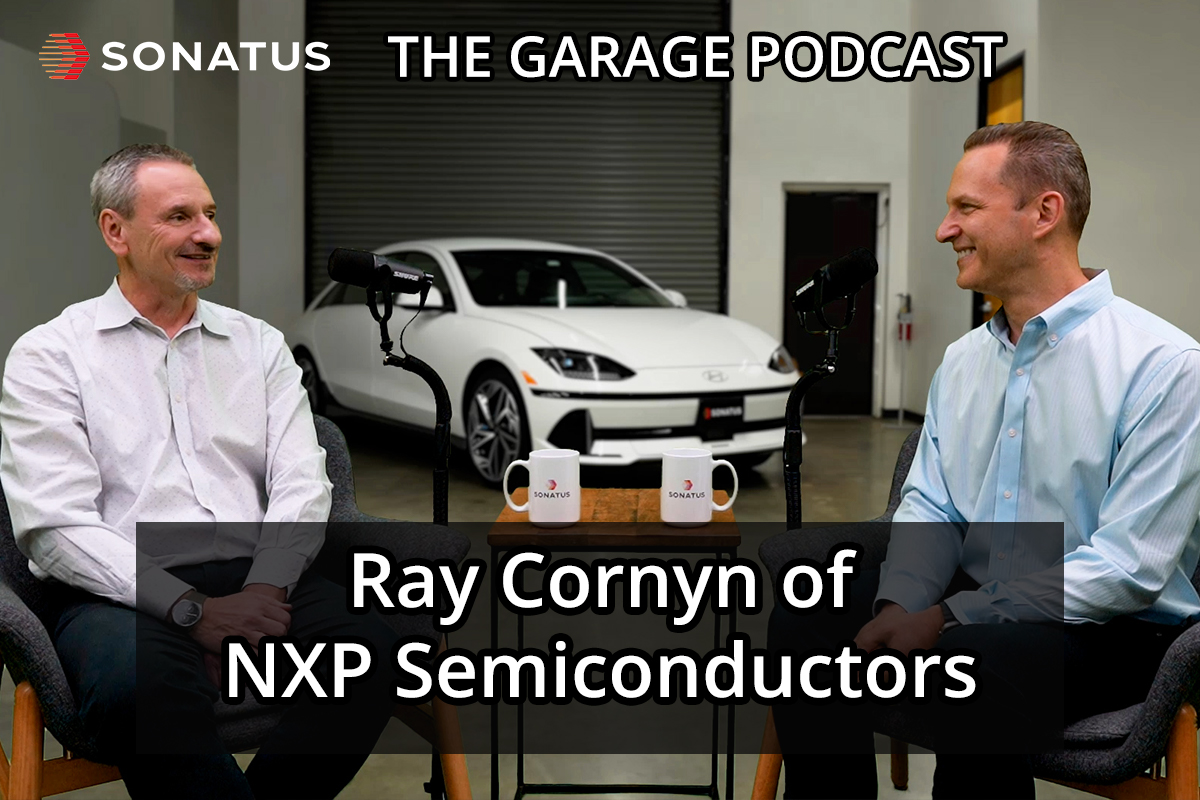
The Garage Podcast
Ray Cornyn of NXP Semiconductors
Related resources
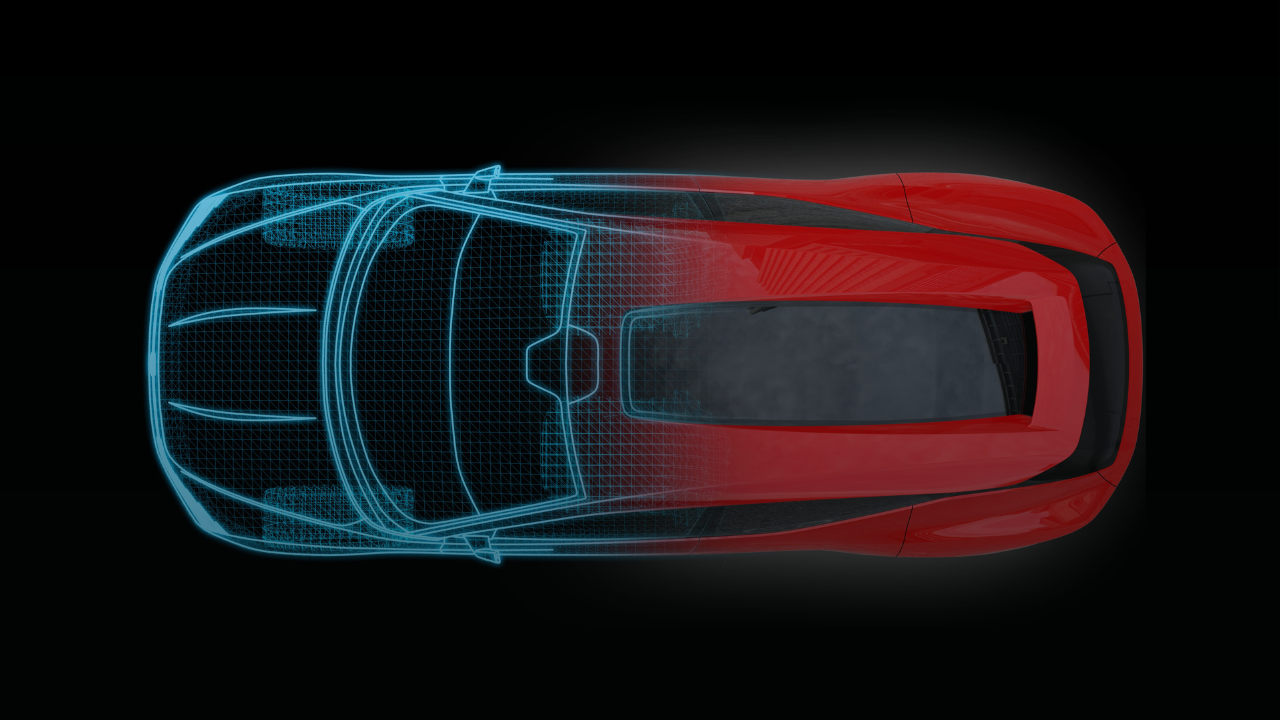
Modern Networks are the Backbone of SDVs
The rise of Software-Defined Vehicles (SDVs) promises a new era in automotive technology, where vehicles continuously improve and new features…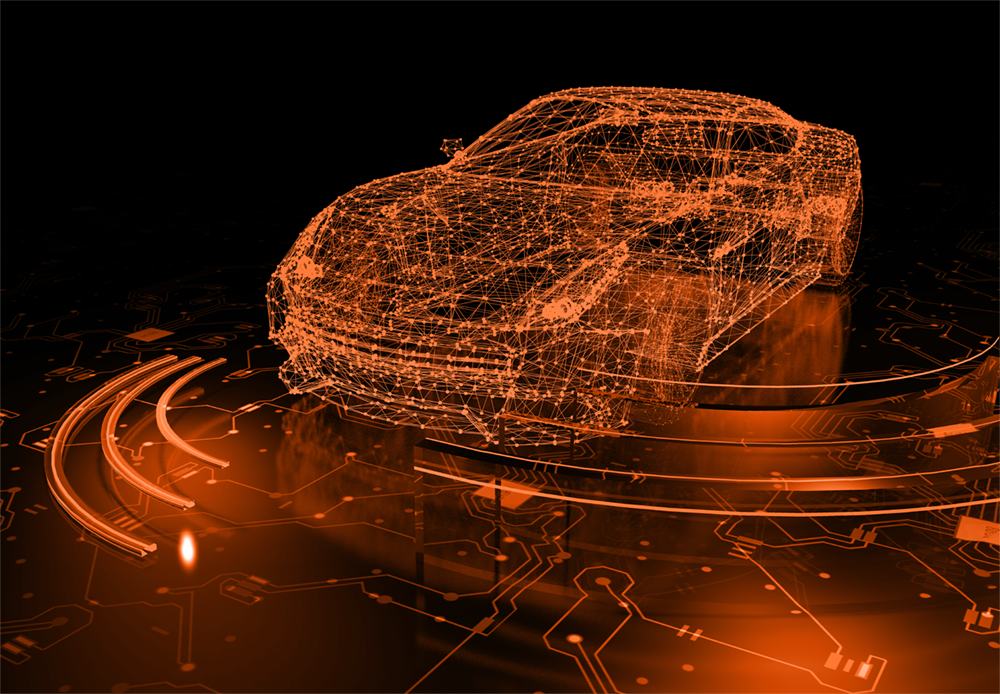
Dynamic Cybersecurity for Connected Vehicles
Why do software-defined vehicles provide a superior platform to prevent, detect, and counter cyberattacks?